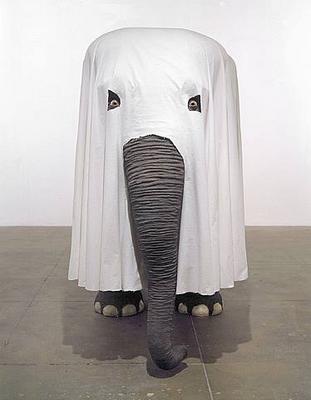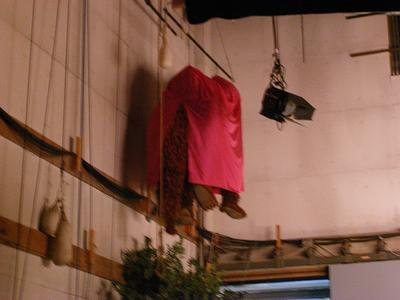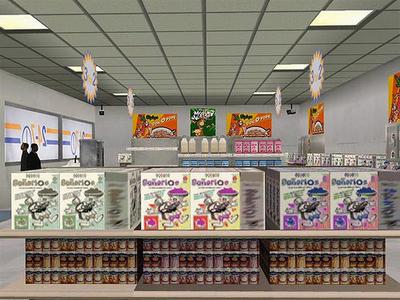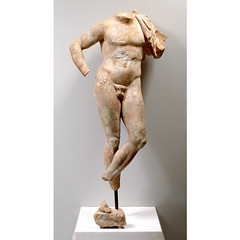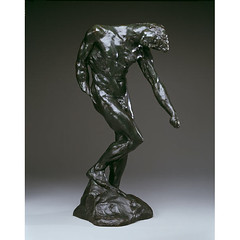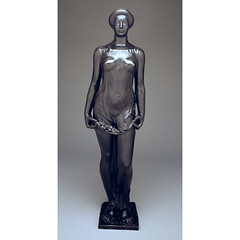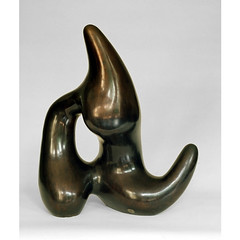Sorry, I was out of town. Did anything happen art-wise while I was gone?
On the film/editing front, the votes were in, and I’m pleased to announce a new addition to the greg.org team: a husky MacBookPro and a couple of new external drives for the road.
Thanks to everyone who shared their advice and insights. Ultimately, it was the memory and video processing requirements of Final Cut Pro and DVD Studio Pro [and the slightly unwieldy size of the 17-inch version] that made the decision.
Category: art
Arty Like It’s 2001
Roll up a host of moribund art magazines.
Start an art news portal.
Launch a big, glogsy new magazine about the [sic] Biennale Lifestyle.
Buy an art fair.
It hurts to say it because I have friends there, but am I the only one who thinks everything LTB does is like five years behind the actual art world it’s chasing?
Rather than be an also-ran in every possible endeavor, why not take some time to think and get ahead of the game? Make a difference and stake a claim and support something that no one else is, or that no one else can see? Rather than be the artnet of 1997, why not be the artangel of 1993? Or the early Lightning Field-era Dia of 1977, or of Chelsea-settling 1987, for that matter? Or the Lannan Foundation of whenever?
Because as the NetJets guy in Miami’ll tell you, the one thing the art world is not short of is ambitious multimillionaires jonesing for an audience.
Art Blimps Over Miami
 It’s what I’ve always said Art Basel Miami Beach needed more of: blimps. And now they’ve got’em. It’s almost enough to make me wish I wasn’t going to be in Kyoto.
It’s what I’ve always said Art Basel Miami Beach needed more of: blimps. And now they’ve got’em. It’s almost enough to make me wish I wasn’t going to be in Kyoto.
A beachside Blimp Parade with characters from artists I actually like, like Ara Peterson, Misaki Kawai, and others, is curated/organized by Friends With You, the Miami vinyl/naugahyde art collective whose Malfi dolls have tea parties with my daughter on a regular basis.
Alas, I’ll be watching the proceedings on flickr.[1]
If you’re free and want to wrangle a blimp Friday, Dec. 7th, 2pm, get in touch with the blimpfolks asap. Details are at supertouch.
[1] Then we’ll reconvene here to talk about the differences between Arne Quinze’s Burning Man-to-Basel publicity stunt for Lexus and an art event sponsored by Scion. It’s not what kind of Toyota you drive that matters; it’s who’s driving.
Starring Steven Siegel As. Banacek.

The FBI said Monday that it has recovered a 1778 painting by the Spanish artist Francisco de Goya that was stolen as it was being taken to an exhibition earlier this month.
“Children with a Cart,” which disappeared en route from the Toledo Museum of Art in Ohio to the Solomon R. Guggenheim Museum in New York City and was valued at about $1.1 million, appeared to be unharmed, said Les Wiser, agent in charge of the Newark FBI office.
Steven Siegel, a spokesman for the FBI, said the bureau recovered the painting Saturday in New Jersey, but would not be more specific about where or how it was located.
FBI Recovers Stolen Goya Painting [ap/seattle p-i via artforum]
And To Think That I Saw It On Sesame Street
Maurizio Cattelan’s Not afraid of love, 2000, shown at Marian Goodman. [via artnet]
and
Mr. Snuffalupagus in storage on the set of Sesame Street [via flickr]
A Roving Smithsonian Site Displacement
Today, this is just one more picture of a well-balanced bastard. Twenty years from now, though, this dude’s family will sell this photo to the Guggenheim:
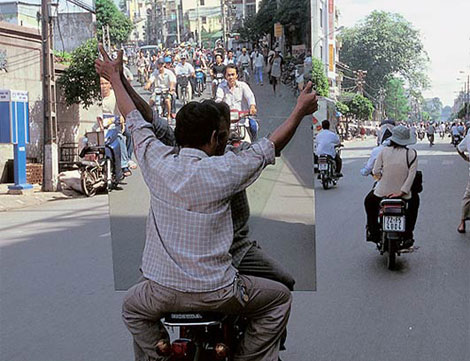
Well Balanced Bastards of The Day [dethroner.com]
The photo’s from Hans Kemp’s book, Bikes of Burden [amazon via kk.org]
Wow. Last-Minute Court Order Blocks Sale Of Blue-Period Picasso Never Mind. Mind, Maybe.
Wow. The sale of one of the paintings I wrote about in the NYT the other day, a blue-period Picasso portrait being sold by Andrew Lloyd Webber,was recently ordered stopped by a Manhattan court. An heir to Paul von Mendelssohn-Bartholdy, who was forced to sell the painting in 1934, filed the suit.
Update: Thanks, Google News. Actually, according to the NYT’s report, the judge refused to block the sale. The Times also mentions the absence of any efforts by the heirs over the last 70 years to pursue a restitution claim, which is why I was surprised in the first place. Go about your business, nothing to see here.
Update update: Or maybe the sale won’t be blocked, just withdrawn. The Art Newspaper’s reporting that Christie’s may hold off on the sale tonight. Good thing that painting’s on one of them Lazy Susan deals.
Picasso Sale Blocked Over Nazi Claims [playfuls.com]
Or Not: Judge Refuses to Halt Auction of a Picasso [nyt]
Christie’s may withdraw Lloyd Webber’s Blue Period Picasso from sale [theartnewspaper.com, thanks marc]
My New Bidding Technique Is Unstoppable
That was my original choice for a title, but I’m happy enough just not botching the Hamlet reference. Thanks to all the people who helped with interviews and research and editing.
Since the story closed, I’ve heard from a couple of people who saw the Dora Maar sale, and it was even more incredible than I thought. Apparently, the guy bidding just kept waving his paddle all the way through the sale, even while he had the bid and was waiting for a competitor to respond. It’s as if he wasn’t following the proceedings at all, just waving the paddle until Tobias Meyer told him he’d won.
Rule No. 1: Don’t Yell, “My Kid Could Do That” [nyt]
Ersatz Serra/Smithson 2-Man Show In Front Of The House
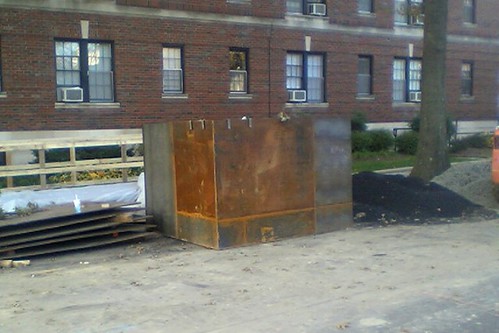
They’re doing construction in DC, and the workers dumped a found-art version of a Richard Serra/Robert Smithson installation in front of our house.
The Relentless Pursuit Of Something, Anyway

Damn, I just hate when that happens. I hate when some sick poseur geezer company who makes SUV’s for orthodontists or whatever totally rips off and corrupts the free, utopian, non-commercial, creative spirit of youth–of the future, even. As if cool were simply something you could buy, or order up by the square foot. As if you could capture the real spirit and meaning of a place like Burning Man in a Beverly Hills storefront. That’s not what it’s all about, man. We go to the playa to get AWAY from our parents’ Lexuses.
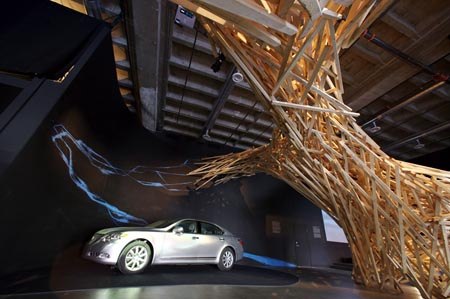
Look what Lexus has done, shamelessly copying the indescribable, ephemeral beauty and power of the Uchronia Project, and turning it into the backdrop for the launch of their new flagship model, the LS 460 sedan.
Forget the ethics of such a blatant act; I want to know logistics. How did Lexus’s agency even have mobilize in time to steal the work of a such a globally visionary and idealistic artist when it only landed at Black Rock City a few weeks ago? It’s as if–what’s that, you say? It’s the same guy?
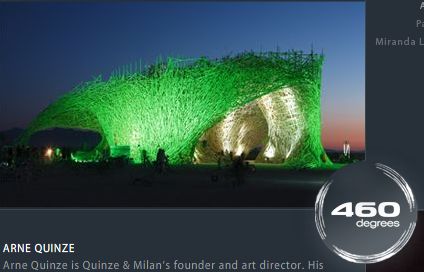
Well. Hate the playa, not the fame, I guess.
Lexus 460 Degrees Gallery [lexus.com via tropolism]Previous
Uchronyism on greg.org:
9/04: to think, there was a day–just one, but still–when it was just about the architecture
9/13: Uchronian partisans and Burning Man roast me for criticizing the Uchronspolitation
9/16:Branding Man [speaks for itself]
10/15: The King of Uchronia meets the Queen of Belgium
Update: There’s a debate raging among burners on tribe.net over whether artist burners should be taking money from corporate sponsors for their work. The answer is obvious: yes, if they want to, but it’s also irrelevant here. The Uchronia project was completely self-funded at BM [i.e., they didn’t get any art grants from BM itself like other projects], and its workers were paid, not volunteers.
What I suspected at the time has, I believe, been proved true now: Uchronia was built as part of an extensive marketing and promotional campaign which used Burning Man as a backdrop and platform to be leveraged externally after the fact. I originally thought it was just a self-promotion scheme for Arne Quinze and his firm, but I think the fully realized Uchronian Lexus Gallery appearing just weeks after BM shows who the real client was.
More evidence: one of the many burners who emailed me a month ago defending the Uchronians shared some of Quinze’s own explanations of his artistic bona fides, “[He said] he’s been selected to be the artist of the year at the upcoming Basel-Miami Art Fair.” Now I may not know Black Rock City, but I do know Basel, and Basel-Miami, and let me tell you, every single attendee there thinks he is “____ of the year.”
But according to Lexus’s gallery touring schedule, their 2-wk/city tour puts them in Miami right around the opening of ABMB. And while he was at BM, Quinze was already planning on taking MB by storm with his unstoppable new marketing technique.
Paul Fusco’s “Bitter Fruit”: Photos Of American Soldiers’ Funerals, 2004-present

Bronx, NY, 2004, Funeral service for Sgt. Luis Moreno
Paul Fusco began photographing the funerals of American soldiers killed in Iraq in 2004 as a “personal protest against government attempts to downplay the costs of war.” It’s not the emotional force of his images that is startling–that’s to be expected, after all–it’s the embarassment and anger that rises up we realize we’ve hardly seen scenes like this at all in the last three years.
It would be easy enough to point fingers at the administration which has actively thwarted coverage of the war’s toll–on both US and Iraqi lives–through a mixture of censorship, dissembling, misinformation, and stonewalled silence.

Bridgeport, CT, 2004, Funeral Service for Spc Tyanna Avery
But Fusco’s images prove that these victims of the war’s violence–the soldiers’ families and communities left behind–could be found and reported, if only editors and prodcuers in the news media had the will, and weren’t so occupied with passing along the more easily obtained, press-release and photo-op-driven stories the government so thoughtfully provides.
Senior leaders in the Defense Department and the White House don’t attend solderis’ funerals out a stated wish not to intrude on the family members’ privacy. Apparently, if the President were to attend, there might be journalists and cameras following along.
Paul Fusco’s exhibition, “Bitter Fruit,” is organized by Magnum Photos and is currently at the Aldrich Contemporary Art Museum through February 2007 [aldrichart.org]
Paul Fusco, “Bitter Fruit,” 46 Pictures [magnumphotos.com]
Wow [Make That, “WoW”]: In-Game Photography
We’re beyond Machinima, people. Some titles have photography as part of the gameplay, and some players are tweaking the games themselves to take in-game photographs.
The results are finding their way onto flickr, like Gregory Perez’s homage [top] to Andreas Gursky’s 99 Cent Store [above], which he shot inside “Grand Theft Auto 4: San Andreas”.
Check out the out-of-focus foreground in this shot by Daniel Kuhne from inside SWAT4. Same focal length effect here, too, in Perez’s shot of a plane.
Marco Cadioli “reports from the war online,” covering battles in MMORPG’s. Some of his black & white photos from “Counter Strike” remind me of stills from Pontecorvo’s The Battle of Algiers. He also “works” as an in-game freelance photojournalist named Marco Manray in Second Life.
There’s even a book coming out, Gamescenes: Art In The Age Of Video Games which includes in-game photography and other artistic and journalistic repurposings.
[via wonderland, where a whole bunch of links are accreting in the comments]
Non-Sensical Non-Site Non-Art?: Smithson’s “Hotel Palenque”

Curator Nancy Spector described Robert Smithson’s Hotel Palenque, which the Guggenheim acquired in 1999 from the artist’s estate [controlled by his widow Nancy Holt and represented by James Cohan Gallery] this way:
Hotel Palenque perfectly embodies the artist’s notion of a “ruin in reverse.” During a trip to Mexico in 1969, he photographed an old, eccentrically constructed hotel, which was undergoing a cycle of simultaneous decay and renovation. Smithson used these images in a lecture presented to architecture students at the University of Utah in 1972, in which he humorously analyzed the centerless, “de-architecturalized” site.
Extant today as a slide installation with a tape recording of the artist’s voice, Hotel Palenque provides a direct view into Smithson’s theoretical approach to the effects of entropy on the cultural landscape.
Smithson’s lecture combines deadpan delivery with absurdist architectural/archeological analysis of a contemporary ruin, a critique–or a spoof–of the kind of academic jargon-laden travelogue usually reserved for slideshows of “real” architecture like the nearby Mayan temple complex.
The lecture is available in several formats: the Guggenheim version was included in the recent MoCA/Whitney retrospective; an illustrated transcript was published in Parkett #43 in 1995; and the incomparable UbuWeb has a 362mb film of the 1972 event for download. [update: uh. ] There was even a “cover version” “performed” by an artist last year in Portland.
But re-viewing the “original” really makes me wonder. The differences between various posthumous incarnations and interpretations of the “Hotel Palenque” lecture seem significant enough to make me question what Smithson actually intended for the lecture, how it was originally received, how it has been contextualized today, and if it is even a “work” at all.
The medium through which art is experienced inevitably influences its perception and interpretation. For an entire generation while it was submerged, the Spiral Jetty “existed”–or was experienced–only through memory, history, text and photo documentation, and, importantly, the artist’s own “making of” film. Once the actual work started re-emerging in 1993-94, its experiential aspects have shifted; now The Visit, the spatial situation, environmental conditions and entropic forces at the site, and the interplay between the Jetty‘s manifestations come to the fore.
Similarly, Palenque is consistently described in hindsight, through the sophisticated conceptual contstruct of Smithson’s writings, but to watch it, Palenque actually sounds like a dorky, rambling joke, more parody than pronouncement. The only real jargon he uses are “situation” [in the architectural sense] and “de-architecturization.” Otherwise, the real/only humor comes from the juxtaposition of his blandly weighty assertions of importance and photos of torn plastic roofing, piles of bricks, and a room propped up by shaky-looking poles [“this is how we approached the site; our car is right there, see between those two columns?”]

The lecture is described as funny, but the only laughter I could hear sounded nervous, or at least tentative. And without knowing anything of how the lecture came to be, and how it was received and reviewed at the time, I can’t help but imagine that some people, like Smithson’s hosts, or his audience, might have felt like the butt of some smart-alecky New York artist’s practical joke. Overall, I guess I find it hard to reconcile Smithson’s sophomoric performance with his hallowed reputation; the lecture fits more neatly with his early, critically challenging “high school notebook doodle” drawings of busty angels than it does with his heavily theoretical Artforum articles.
[It’s worth pointing out that Smithson’s photo/slides, on the other hand, feel very resolved and coherent. I was repeatedly reminded of Gabriel Orozco’s photos of “found” sculptural scenarios and moments, as well as of Smithson’s own Passaic series and other photographs. We have a favorite photo, a top-down shot of a pile of bricks, that he did after returning from the Yucatan; the man does have a way with rubble.]
But the most problematic issue about Palenque could be a non-issue for almost any conceptual artist, but it seems paramount given Smithson’s own ideological concerns with the gallery/museum space and system: to what extent should the lecture be considered “performance” or a “work of art” itself? The Guggenheim’s version of Hotel Palenque consists of a slideshow and an audiotape, which plays in polite form in a museum gallery.
But before/besides that incarnation, the lecture “existed” [or was experienced] as a filmed version, made with a handheld camera seated somewhere in the crowd in Salt Lake City. Smithson himself is off camera, and several times, the slides themselves are, too. The film is a bootleg only to the extent Baltimore artist Jon Routson‘s self-consciously askew video recordings of movies are, which is to say, “not at all.” The amateurish, sometimes forgetful framing and the handheld jitters heighten the experiential, audience perspective. There’s one passage where the camera bobs up and down in synch with its operator’s breathing. These are all central, even overwhelming, elements of the Palenque film, and they’re utterly absent from the “institutionalized” version, just as Smithson’s delivery is lost in the Parkett transcript [a version which no one would mistake for anything but documentation or reportage.] It’s enough to make me wonder just what the Guggenheim bought–or just what the Smithson estate sold–with Hotel Palenque which, by 1999, had to be one of the few significant “pieces” or, less problematically, holdings, left in the estate.
The Guggenheim also bought, at the same time, nine slides of Yucatan Mirror Displacements, iconic images of landscape interventions which Smithson made on the same 1969 trip. But these slides–which illustrated an Artforum essay and are widely reproduced in print–have never existed to my knowledge in artist-sanctioned formats like traditionally editioned prints. I’d be very interested to see documentation or scholarship on this question–which is also a fancy way of saying I have no idea or direct knowledge at this point–to see just how closely Smithson’s definition of defined, purchasable work jibes with notions operative in 1999 among art dealers and museum acquisition committees.
Because there have already been plenty of cases where Smithson’s ideas, his works, and his estate’s interpretations of them sometimes seem out of synch. Had Smithson not died suddenly and tragically the next year would this offhand-seeming ramble be treated with even a fraction of the reverence it has received? And if there had been more sculptures and clearly identifiable “work” to sell in the estate when Smithson’s star re-emerged in the late 1990’s, would Hotel Palenque ever have made it out of the archives and into a major museum’s collection?
Previously: UT gov’t decides to clean up the Jetty site
Nancy Holt floats the idea of “restoring” the Jetty
“The Spiral Doily”: What if sprawl is the real entropy?
Other Smithson-related posts on greg.org
Elsewhere: Brian Dillon’s appreciation of the lecture as artform in Frieze
Alberto Burri’s Cretto

Like Pompeii in reverse, Gibellina has been remembered by its ghost-like burial instead of an unearthing.
In 1968, an earthquake devastated villages throughout the Belice Valley of western Sicily. The Italian government’s incompetent response to the disaster and the corruption that absorbed rescue & redevelopment funds turned “Belice” into a cautionary touchstone of Italian politics. It’s a scenario that might resonate today, even. In the United States. And/or in Iraq.
Anyway, in the mid-80’s, artist Alberto Burri proposed a memorial to victims of the earthquake. His plan: encase the ruins and detritus of the abandoned hill town of Gibellina in concrete, leaving the roads as a solid, labyrinthine palimpsest of the village’s public spaces. [The whole town had been rebuilt and relocated closer to the freeway soon after the earthquake. No preserve-or-rebuild debates there.]
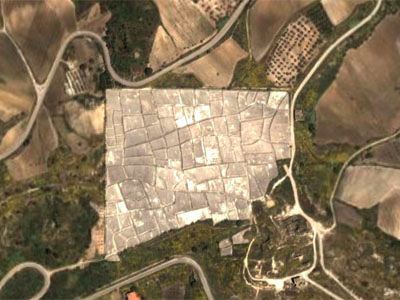
The remarkable thing: the memorial was built. Cretto is now a 20+ acre piece of mesmerizing land art, the pathways of an entire town petrified in brutalist, post-minimalist concrete. Now, of course, in 2006, it looks like Peter Eisenman’s Berlin Holocaust Memorial, but with content. The other thing it reminds me of is an old NYT Magazine article [date? who knows?] about the challenge of designing effective warning signs for a Nevada nuclear waste dump. To get the “Keep Out” message across 10,000 years from now, someone suggested paving a giant desert quadrant with spiky black stone, which the heat alone would render nearly impassable. Haven’t heard much about that since.
Other things I haven’t heard: anyone–even the memorial experts–discuss Burri’s work in relation to the World Trade Center site, or even in the larger contexts of the evolution of memorial design, much less of Land Art. What gives?
Aleksandra Mir mentioned Cretto in her top ten list for this month’s Artforum [artforum]
Cretto [archidose talked about it, though. twice.]
09/2010 UPDATE Google Maps now has higher res images, and Street View. of BF Sicily.
Four Nudes Too Nude For Texas
As has been reported before, Ms. Sydney McGee, an 28-year veteran art teacher in a Texas elementary school has been suspended after a parent complained that his/her child saw nude art during a field trip to the Dallas Museum of Art. The field trip had been approved by the principal; there were other teachers and parents along; and the museum reports it has never had such a complaint from a school group in its history.
The teacher retraced the group’s steps for the NY Times, which noted the following nude works:
Figure of a Young Man from a Funerary Relief, Greek; Attic
c. 330 BC
The Shade, Auguste Rodin, 1880 [which is under 1m tall, btw]
Flora, Aristide Maillol, 1911 [which is actually draped with a robe of some sort]
And Star in a Dream, Jean Arp, 1958, the nudity of which seems to me beyond the reach of most fifth grade imaginations.
There is, however, another Arp that fits the description of “an abstract nude sculpture,” a phrase the principal apparently cited in the suspension:
Sculpture Classique, 1960, which the artist made in a “conscious attempt” to “emulate the basic forms of Greek art.” If this is the offending sculpture, I think there’s a parent who needs a time out.
Still, my money’s on the Maillol, if for no other reason than that it looks suspiciously like Paul Jennewein’s Spirit of Justice, 1933, a statue whose exposed breast made John Ashcroft want to–well, let’s let him demonstrate. In a way, this whole story now makes perfect sense.


